The doorway to Christianity in Europe
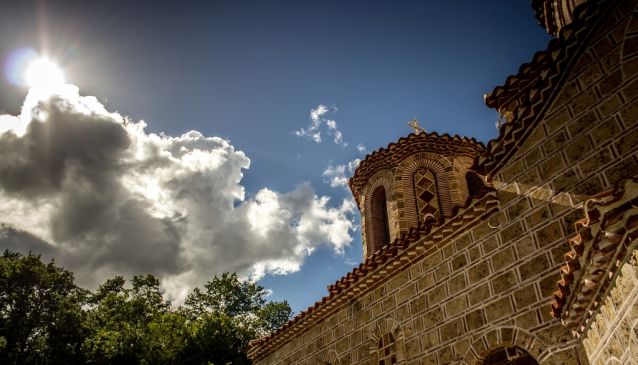
Macedonia takes the first place in the Balkans according to the number of monasteries and churches. Some data available says that there are about 155 preserved monasteries and 90 more in ruins. These representatives of our cultural heritage and medieval art are located throughout the whole territory of Macedonia, hidden in the middle of the most beautiful natural scenery and landscape. For centuries, they have been spiritual centers, sources and witnesses of the Macedonian orthodoxy. Today they are inexhaustible source and challenge for people that are in search of the iconic spiritual and cultural values.
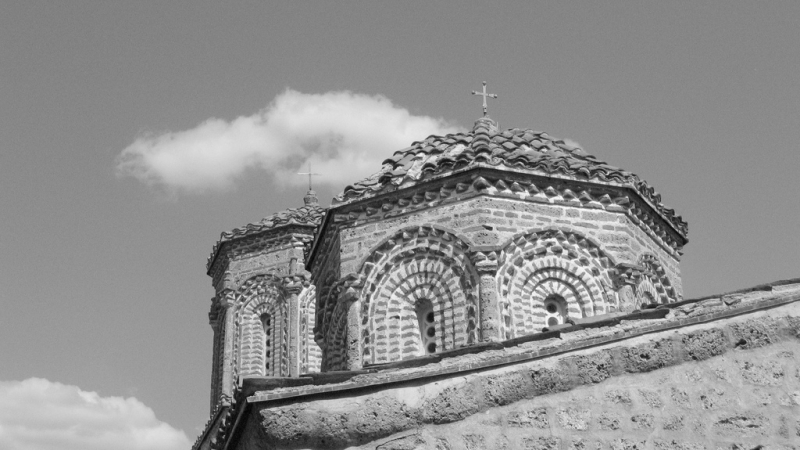
St. Naum Monastery (photo by: Ana Karenina)
One of the oldest and the richest monasteries in Macedonia is St. Naum’s monastery, located 29 km away from Ohrid. The monastery is on an elevated plain on the southern coast of the Ohrid Lake, near the springs of the Drim river, and is dedicated to St. Archangel Michail and St. Archangel Gabriel. Its creator St. Naum of Ohrid, contemporary and associate of St. Clement of Ohrid and student of the legendary Cyril and Methodius brothers, had established this monastery towards the end of his life (900-905). St. Naum was well-known as a healer and miracle-worker, which is witnessed by the motifs in the icons painted in the second zone of his crypt. He died in 910 A.D. and was buried in the monastery. During the Ottoman period the church was demolished. In the XVI and XVII century, the foundation of original structure, was used for the construction of the present church, which was later enlarged several times. As one of the inscription reads, the fresco-painting was completed in 1806, when also the chapel of the tomb of St. Naum was painted.
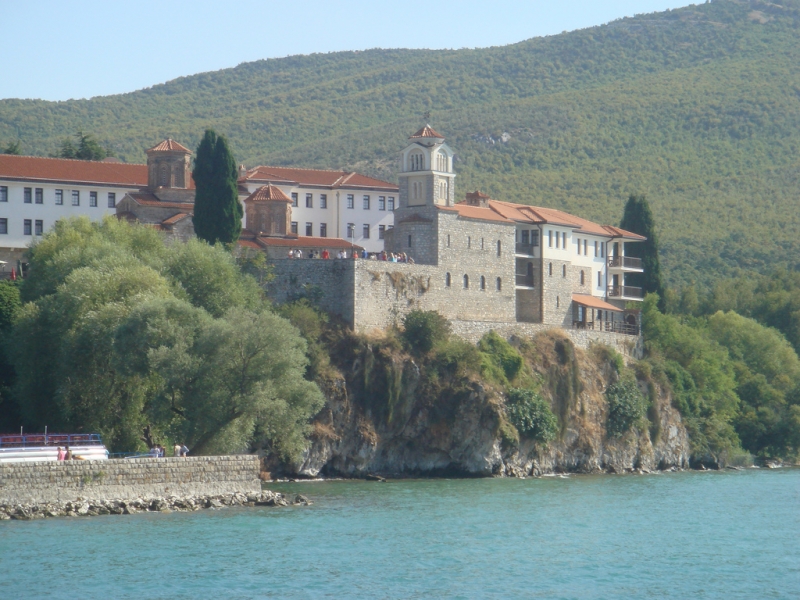
St. Naum Monastery (photo by: Will)
The iconostasis placed in the central part of the church, was performed in 1711 in the technique of shallow wood-carving, and has special artistic value. The throne icons are considered to be among the best achievements of the first half of the 18th century in Macedonia. You’ll enjoy every moment of your visit of St.Naum’s monastery, from arriving here, whether with a boat through lake Ohrid or by car and passing alongside the biggest springs on the Ohrid coast, to exploring the history and legends connected with this temple. The whole complex is special due to its rare natural beauty, clear waters and the serenity it offers.
The monastery in Lesnovo is one of the largest, most visually stunning and culturally significant monasteries in Eastern Macedonia, with a long history that probably begins in the 11-th - 12-th century. Like many other medieval monasteries the Lesnovo complex composed of its monastery dedicated to St. Gavril Lesnovski and the church dedicated to St. Archangel Michail, is located up a long and imposing mountain road, on the south-western slopes of Mount Osogovo, at an altitude of about 1.118m and on the beginning of the village of Lesnovo which is spread over an old volcanic area. The Lesnovo crater is a masterpiece of nature and its beauty is compared with the Vulcan Etna in Italy. The monastery is surrounded with very interesting landscape, predominately rocks, naturally shaped, among which the most impressive is one that looks like “The Virgin Mary with a Child”. The Church was built between 1341 and 1349, by the ruler Oliver 1st, on the foundations of an older shrine that existed in the 11th century during the time of the Vulnerable hermit Gabriel of Lesnovo. In the past more than 200 monks lived in the monastery, making Lesnovo great spiritual sanctuary and a centre of the medieval Kratovo literary school. According to a manuscript from the 19th century the monastery library used to hold more than 20 loads of religious manuscripts, which nowadays can be found in libraries in Belgrade, Sofia, Zagreb, Moscow, Saint Petersburg and in private libraries. The monastery is also known for its fresco-paintings dating from the time of the construction of the church and the wood-carved iconostasis from 1811, a work of art performed by the Mijak craftsman.
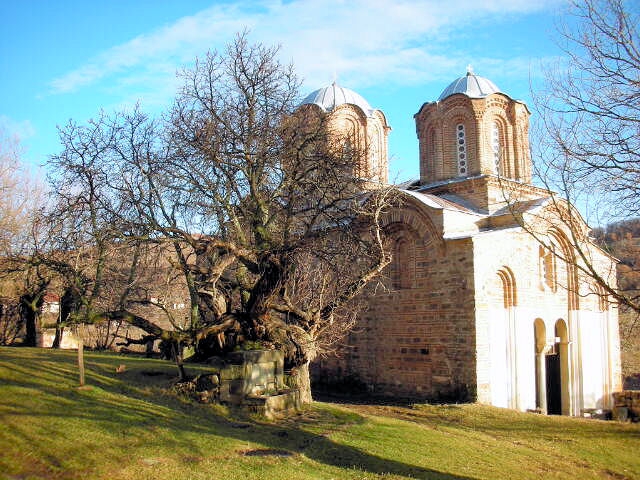
Lesnovo Monastery and the old tree (photo by: Vesna Markovska)
Another curiosity is that here you’ll see a mulberry tree in form of a cross which is around 600 years old. The fruits of this tree are unusually large, delicious and black, they change the colour and the trace from them on your clothes is very difficult to remove. According to the hosts - Lesnovo monks there are only three such trees on the Balkans.
If you are in north-eastern Macedonia headed towards the border crossing with Bulgaria, Deve Bair, and an asphalt road will lead you to the monastery founded in 11th – 12th century “ Saint Joachim Osogovski”. Hidden in the tranquillity, lush forests and surrounded by Osogovo Mountains peaks, at the altitude of 825m, Osogovo monastery is considered to be one of the most beautiful monasteries in Macedonia. The complex consists of two churches (one smaller with remnants from the 14th century, and a bigger – cathedral church dating from the 19th century), old restored lodging houses, residential and buildings of more recent dating, economic buildings with barns and alike. The facilities for overnight stay in the monastery were built in the traditional style, used for accommodating visitors, and with the biggest overnight capacity of this kind in the whole country. The large three-nave basilica, built in 1851 by Andrej Damjanov, has 12 domes, which represent the 12 apostles, and open porches on its western and southern sides. The holy relics of Saint Joachim of Osogovo are located to the right of the church entry, underneath the wall with the most impressive wall painting - the portrait of the saint created by Dimitar Andonov Papradishki. Iconostasis includes wood-carved Royal Doors - work of Nikola, son of zograph from Samarina. The church that stood the test of time as an earthquake, demolishing from the Turks, and desolation during the entire 18th century, today is ranked among the most distinguished cathedral churches in Macedonia built during the Revival in the first decades of the 19th century.
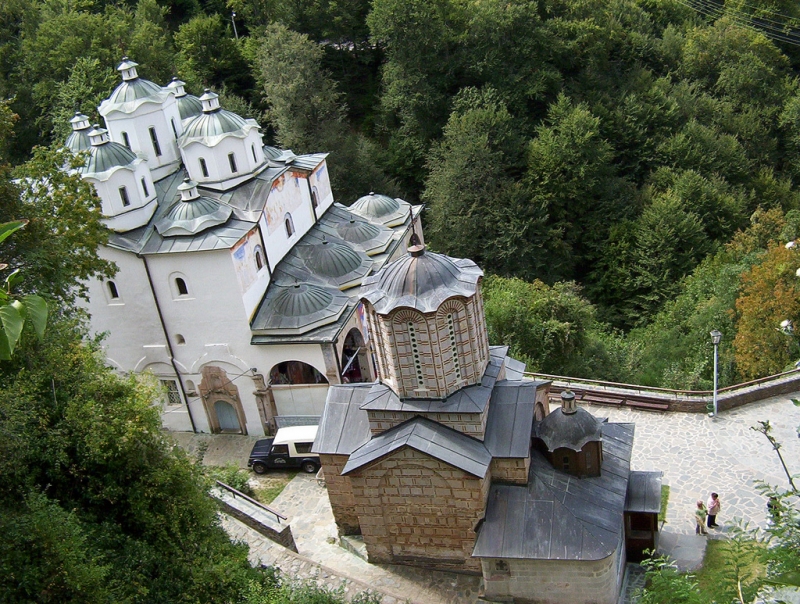
St. Joachim Osogovski Monastery (photo by: Vesna Markovska)
In the western part of Macedonia, above the valley of Radika river, hidden in the beautiful slopes of Mount Bistra and surrounded by an exuberant forest, the monastery St. John the Baptist – Bigorski is ensconced. The monastery affords a magnificent view of the mountain Korab with its two peaks Small and Big Krchin, and of four picturesque villages.
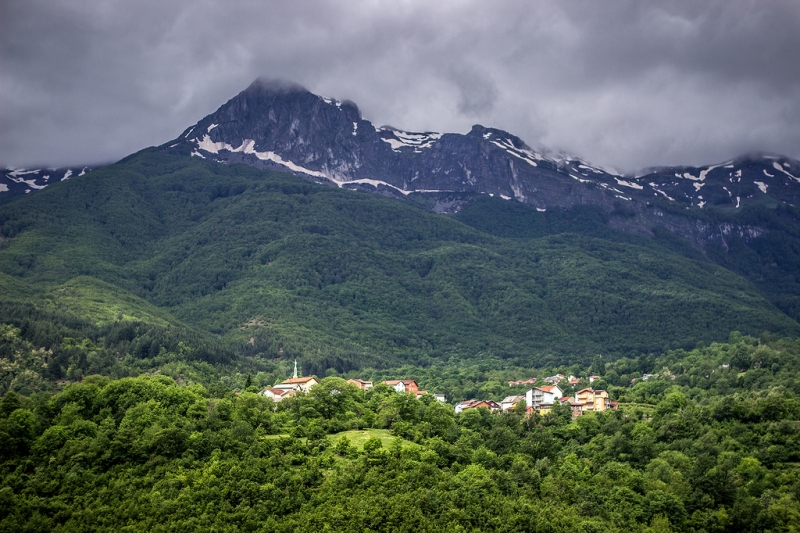
View from John Bigorski Monastery (photo by: Marjan Lazarevski)
The monastery chronicles tell us that it was established in 1021 AD, but the actual buildings that can be seen today originate from the 18th and beginning of the 19th century. The latest construction work was made few year ago after a fire accident in 2009, which luckily did not make any damage to the most valuable object –the monastery church dedicated to St. John – the Forerunner which in construction is very similar to the Holy Mountain monasteries. The iconostasis here is a unique, priceless masterpiece of woodcarving, performed by Miyak craftsmen headed by Petre Filipovski – Garkata. Adjusted to the dimensions of the church, divided in 6 horizontal zones, on a limited space the masters carved scenes from both the Old and New Testament, presenting more than 500 human images, 200 different animals interwoven in floral ornaments with a realistic presentation of a grape vine, flowers of narcissus, garden roses, oriental fruits and cracked pomegranates, all of them combined in perfect harmony. Another valuable monastery treasure is an icon dating from 1020 with supposedly miraculous healing power.
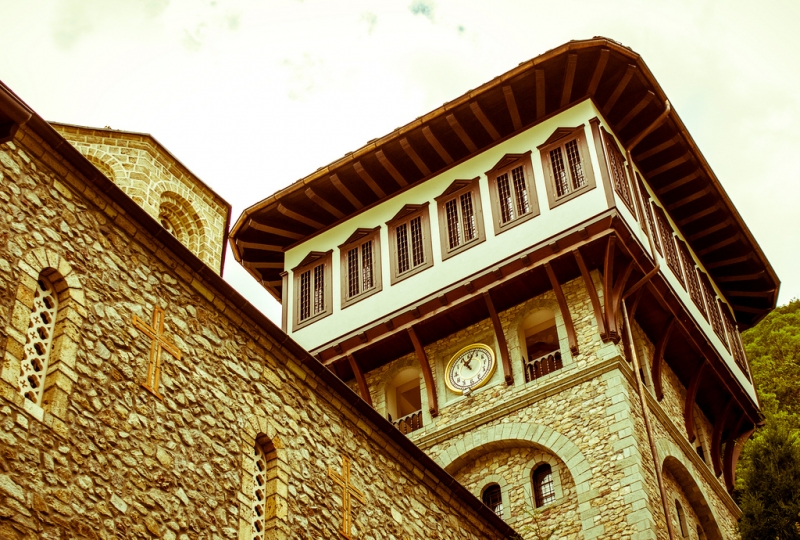
John Bigorski Monastery (photo by: Marjan Lazarevski)
One of the most important churches in Macedonia is the church dedicated to the Dormition of the Holy Virgin, part of Treskavec monastery complex. Situated under the peak Zlatovrv, in a striking mountain landscape, with magnificent view of Pelagonija valley, mountains Babuna, Pelister and Kajmakchalan and at night of the city lights of Prilep, Bitola and Krushevo.
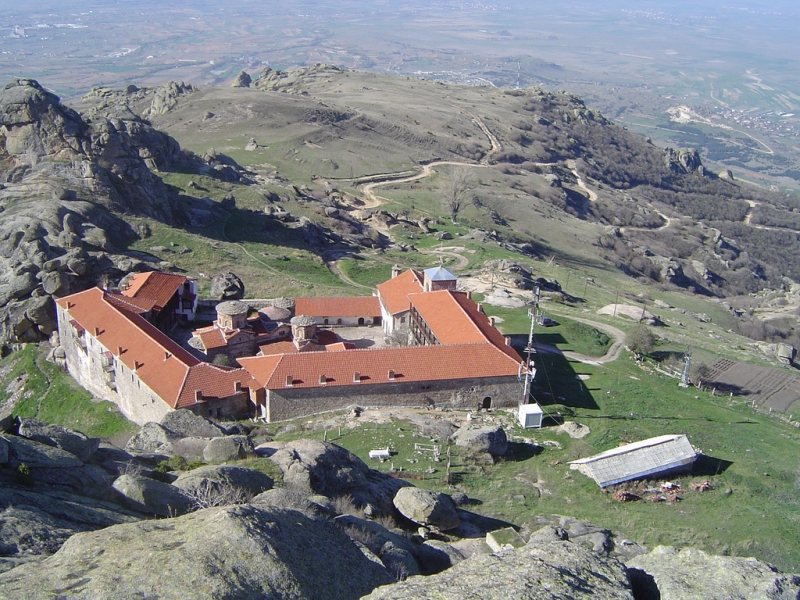
Treskavec Monastery (photo by: Vesna Markovska)
The place is so inaccessible in the rocks, it's a miracle how the complex was built. It is considered that the monastery was founded on top of an antique fortress in the 13-th century, and renovated in the 14-th century, during the time of the Serbian king Milutin. As many other monasteries in Macedonia Treskavec has also been ruined and neglected during the first years of the 15th century, but also renovated later. The fresco-paintings of the church originate from various time periods, but the frescos in the two towers, displaying saints in their full posture, are considered to be the oldest, dating from the first half of the 14th century. The monastery’s facade is made from faded red bricks, with ornamental external niches and with the uneven roof, it looks like it was created at the same time as the rocks surrounding it. Other exquisite parts of the church is the wooden gate which dates back to the XIV century and belongs to the Prilep-Slepce art school. Here are recorded scenes from two movies of famous Macednoian director Milco Mancevski, "Before the Rain" and "Dust". Because of its unique beauty the monastery is attractive to many foreign tourists and mountaineers which like to hike the 8km trail from Prilep. In 2013 the municipality of Prilep completed the project to connect the monastery with the city with an asphalt road making it easily accessible for visitors and significantly improving the access for church clerks.